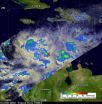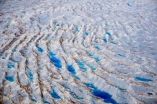(Press-News.org) ANN ARBOR, Mich.---The results of a high-profile Fermilab physics experiment involving a University of Michigan professor appear to confirm strange 20-year-old findings that poke holes in the standard model, suggesting the existence of a new elementary particle: a fourth flavor of neutrino.
The new results go further to describe a violation of a fundamental symmetry of the universe asserting that particles of antimatter behave in the same way as their matter counterparts.
Neutrinos are neutral elementary particles born in the radioactive decay of other particles. The known "flavors" of neutrinos are the neutral counterparts of electrons and their heavier cousins, muons and taus. Regardless of a neutrino's original flavor, the particles constantly flip from one type to another in a phenomenon called "neutrino flavor oscillation."
An electron neutrino might become a muon neutrino, and then later an electron neutrino again. Scientists previously believed three flavors of neutrino exist. In this Mini Booster Neutrino Experiment, dubbed MiniBooNE, researchers detected more oscillations than would be possible if there were only three flavors.
"These results imply that there are either new particles or forces we had not previously imagined," said Byron Roe, professor emeritus in the Department of Physics, and an author of a paper on the results newly published online in Physical Review Letters.
"The simplest explanation involves adding new neutrino-like particles, or sterile neutrinos, which do not have the normal weak interactions."
The three known types of neutrino interact with matter primarily through the weak nuclear force, which makes them difficult to detect. It is hypothesized that this fourth flavor would not interact through the weak force, making it even harder to find.
The existence of sterile neutrinos could help explain the composition of the universe, said William Louis, a scientist at Los Alamos National Laboratory who was a doctoral student of Roe's at U-M and is involved in the MiniBooNE experiment.
"Physicists and astronomers are looking for sterile neutrinos because they could explain some or even all of the dark matter of the universe," Louis said. "Sterile neutrinos could also possibly help explain the matter asymmetry of the universe, or why the universe is primarily composed of matter, rather than antimatter."
The MiniBooNE experiment, a collaboration among some 60 researchers at several institutions, was conducted at Fermilab to check the results of the Liquid Scintillator Neutrino Detector (LSND) experiment at Los Alamos National Laboratory, which started in 1990. The LSND was the first to detect more neutrino oscillations than the standard model predicted.
MiniBooNE's initial results several years ago, based on data from a neutrino beam (as opposed to an antineutrino beam), did not support the LSND results. The LSND experiment was conducted using an antineutrino beam, though, so that was the next step for MiniBooNE.
These new results are based on the first three years of data from an antineutrino beam, and they tell a different story than the earlier results. MiniBooNE's antineutrino beam data does support the LSND findings. And the fact that the MiniBooNE experiments produced different results for antineutrinos than for neutrinos especially astounds physicists.
"The fact that we see this effect in antineutrinos and not in neutrinos makes it even more strange," Roe said. "This result means even more serious additions to our standard model would be necessary than had been thought from the first LSND result."
The result seems to violate the "charge-parity symmetry" of the universe, which asserts that the laws of physics apply in the same ways to particles and their counterpart antiparticles. Violations of this symmetry have been seen in some rare decays, but not with neutrinos, Roe said.
While these results are statistically significant and do support the LSND findings, the researchers caution that they need results over longer periods of time, or additional experiments before physicists can rule out the predictions of the standard model.
###
The paper is called "Event Excess in the MiniBooNE Search for ν̅ μ→ν̅ e Oscillations." It will be published in an upcoming edition of Physical Review Letters.
This research is funded by Fermilab, the Department of Energy and the National Science Foundation.
For more information:
Byron Roe: http://gallatin.physics.lsa.umich.edu/~roe/
MiniBooNE: http://www-boone.fnal.gov/index.html
Full text of paper: http://prl.aps.org/abstract/PRL/v105/i18/e181801
END
New Haven, Conn. -- New applications of information and communication technology (ICT) that could save society significant amounts of energy and money and reduce greenhouse gas emissions that are warming the planet are explored in a special issue of Yale's Journal of Industrial Ecology.
These applications exploit recent advances in ICT, such as social networking and Web 2.0, smart energy monitoring and geographic information systems, and are explored in depth in the special issue "Environmental Applications of ICT," published with support from the Leading Edge Forum ...
The Tropical Rainfall Measuring Mission (TRMM) satellite traveled over Tomas twice on Tuesday, Nov. 2. The second time was at 2005 UTC (4:05 p.m. EDT) when it was still classified as a tropical storm. During TRMM's second overpass, Tomas' center of circulation wasn't evident. Today, Nov. 3 that center is reforming.
During the morning hours on Nov. 3, an Air Force hurricane hunter aircraft found no tropical storm force winds so Tomas was downgraded by the National Hurricane Center to a tropical depression.
At 2 p.m. EDT on Nov. 3, Tomas was undergoing some changes, and ...
VIDEO:
Two spiral galaxies undergo a protracted crash lasting two billion years, eventually merging into a single elliptical galaxy.
Click here for more information.
As scientists and engineers work to make NASA's James Webb Space Telescope a reality, they find themselves wondering what new sights the largest space-based observatory ever constructed will reveal. With Webb, astronomers aim to catch planets in the making and identify the universe's first stars and galaxies, yet ...
NEW YORK (Nov. 3, 2010) -- Scientists at Weill Cornell Medical College have taken an important step toward a better understanding of prostate cancer by uncovering evidence that it is not one disease, as previously believed, but rather several factors which can be measured and, in the future, destroyed by targeted therapy.
The research team led by of Dr. Mark A. Rubin, the Homer T. Hirst Professor of Oncology in Pathology and vice chair for experimental pathology at Weill Cornell Medical College, identified secondary mutations that cause some types of prostate cancer ...
More than 30 million people in the United States travel to resource-limited areas of the world each year. This global mobility may contribute to the spread of infectious diseases – such as influenza, measles, and meningitis – and may also put individual travelers at risk for malaria, typhoid, dengue fever and hepatitis. Despite these potential risks, a recent study conducted by the Division of Infectious Diseases at Massachusetts General Hospital (MGH) and published in the Journal of Travel Medicine found that 46 percent of travelers to resource-limited countries did ...
NEW YORK (Nov. 3, 2010) -- Diffuse large B-cell lymphoma (DLBCL) is a type of aggressive non-Hodgkin's lymphoma that accounts for approximately 40 percent of lymphomas among adults. If left untreated, it is fatal. The existing treatments have a cure rate that is slightly over 50 percent but destroy healthy cells along with the cancer cells.
Researchers at Weill Cornell Medical College have found a combination therapy that is more effective than traditional treatments and is able to kill the cancer cells without harm to surrounding tissues. In a paper published in the ...
CINCINNATI—Researchers at the University of Cincinnati (UC) and the Cincinnati Veterans Affairs (VA) Medical Center have found that about one-third of chronic kidney disease patients who are prescribed therapies for high blood pressure do not often adhere to treatments.
This report was published in the Nov. 2 online edition of the American Journal of Nephrology.
The study, led by researchers at UC and the Cincinnati VA, showed that treatment of hypertension in patients with chronic kidney disease continues to be a challenge in their care and that by simply improving ...
Researchers at Mount Sinai School of Medicine have found that 98 percent of the U.S. population lives in communities within 60 minutes of a hospice provider, suggesting that disparities in use of hospice are not likely due to a lack of access to a hospice provider. The results are published in the current issue of the Journal of Palliative Medicine.
"Despite a significant increase in the availability of hospice services during the past decade, the majority of Americans die without hospice care," said Melissa D.A. Carlson, PhD, Assistant Professor of Geriatrics and Palliative ...
VIDEO:
Video opens with footage of a common cornstarch and water experiment. Ian Oberst, a visiting student from Portland Community College who participated in the University of Oregon's UCORE program for...
Click here for more information.
Mix two parts cornstarch and one part water. Swirl your fingers in it slowly and the mixture is a smoothly flowing liquid. Punch it quickly with your fist and you meet a rubbery solid -- so solid you can jump up and down on a vat of it.
It ...
Melt water flowing through ice sheets via crevasses, fractures and large drains called moulins can carry warmth into ice sheet interiors, greatly accelerating the thermal response of an ice sheet to climate change, according to a new study involving the University of Colorado at Boulder.
The new study showed ice sheets like the Greenland Ice Sheet can respond to such warming on the order of decades rather than the centuries projected by conventional thermal models. Ice flows more readily as it warms, so a warming climate can increase ice flows on ice sheets much faster ...

